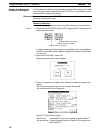
3-4SectionConnecting a Bar Code Reader
38
Make the settings shown in the table below at the bar code reader. Make sure
that the communications speed, parity, stop bit, and data bit settings match the
communication settings made at the NT31/NT31C. For details on the setting
method, refer to the instruction manual for the bar code reader used.
Item Possible Settings
Communications speed 4800, 9600, 19200 bps
Parity EVEN, ODD, NONE
Stop bits 1 or 2 bits
Data bits 7 or 8 bits
Preamble STX
Postamble ETX
RS/CS control Available
Communication protocol No-protocol mode
Transmission of number of bar code label digits Transmission prohibited
Transmission of ID characters Transmission prohibited
Bar code types Multi-reading (all types can be
read)
Trigger switch setting Automatic reading mode
About RS/CS Control
During bar code reading, the NT31/NT31C performs RS/CS control. When the
Input Method setting of the NT31/NT31C is set to Auto, the RS signal is turned
OFF, prohibiting the next input, until the read data has been notified to the host.
Because of this, when the Auto setting is made, the next input is not possible
until the data has been notified to the host.
However, when the setting is Auto and the RS/CS signals of the cable are
shorted, RS/CS control is ineffective. Consequently, data input from the bar
code reader to the NT31/NT31C is updated regardless of whether or not the data
is notified to the host.
For details, refer to the instruction manual for the bar code reader used.
3-4-3 Data Format
The data format for communication when using the bar code input function of the
NT31/NT31C is shown below.
Data Data DataSTX ETX
(03H)(02H)
The characters which are effective as data are hexadecimal codes from 20 to
7F
H, and the maximum data length is 40 bytes.
Data which does not follow the data format described above is invalidated and
discarded.
Settings at the Bar Code
Reader


















